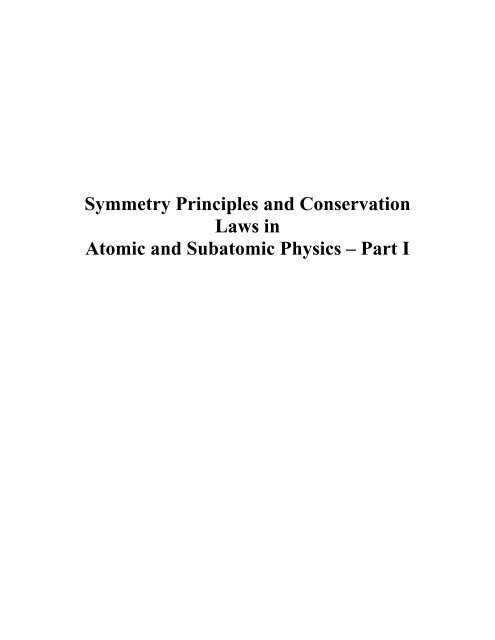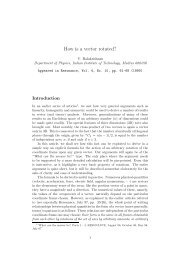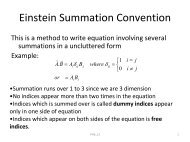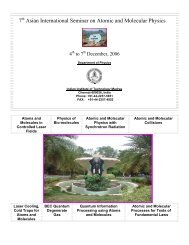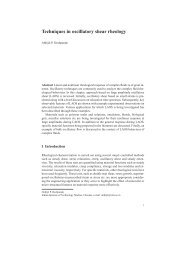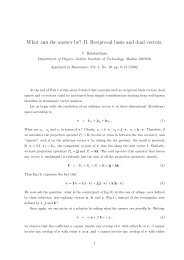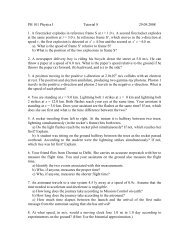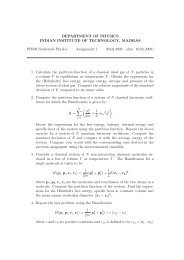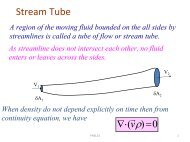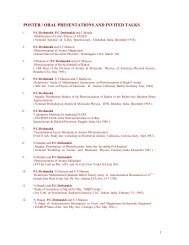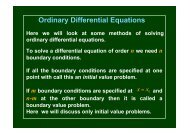Symmetry Principles and Conservation Laws in Atomic and ...
Symmetry Principles and Conservation Laws in Atomic and ...
Symmetry Principles and Conservation Laws in Atomic and ...
Create successful ePaper yourself
Turn your PDF publications into a flip-book with our unique Google optimized e-Paper software.
<strong>Symmetry</strong> <strong>Pr<strong>in</strong>ciples</strong> <strong>and</strong> <strong>Conservation</strong><strong>Laws</strong> <strong>in</strong><strong>Atomic</strong> <strong>and</strong> Subatomic Physics – Part I
GENERAL ARTICLE<strong>Symmetry</strong> <strong>Pr<strong>in</strong>ciples</strong> <strong>and</strong> <strong>Conservation</strong> <strong>Laws</strong> <strong>in</strong><strong>Atomic</strong> <strong>and</strong> Subatomic Physics – 1P C Deshmukh <strong>and</strong> J Libby(left) P C Deshmukh is aProfessor of Physics at IITMadras. He leadsan active research group <strong>in</strong>the field of atomic <strong>and</strong>molecular physics <strong>and</strong>is <strong>in</strong>volved <strong>in</strong> extensiveworldwide researchcollaborations <strong>in</strong> boththeoretical <strong>and</strong> experimental<strong>in</strong>vestigations <strong>in</strong> thisfield. He enjoysteach<strong>in</strong>g both undergraduate<strong>and</strong> advanced graduatelevel courses.(right) Jim Libby is anAssociate Professor <strong>in</strong> theDepartment of Physics atIIT, Madras. He is anexperimental particlephysicist specialis<strong>in</strong>g <strong>in</strong> CPviolat<strong>in</strong>g phenomena.Keywords<strong>Symmetry</strong>, conservation laws,Noether’s theorem.The whole theoretical framework of physics restsonly on a few but profound pr<strong>in</strong>ciples. Wignerenlightened us by elucidat<strong>in</strong>g that \It is now naturalfor us to try to derive the laws of nature<strong>and</strong> to test their validity by means of the laws of<strong>in</strong>variance, rather than to derive the laws of <strong>in</strong>variancefrom what we believe to be the laws ofnature." Issues perta<strong>in</strong><strong>in</strong>g to symmetry, <strong>in</strong>variancepr<strong>in</strong>ciples <strong>and</strong> fundamental laws challengethe most gifted m<strong>in</strong>ds today. These topics requirea deep <strong>and</strong> extensive underst<strong>and</strong><strong>in</strong>g of both`quantum mechanics' <strong>and</strong> the `theory of relativity'.We attempt <strong>in</strong> this pedagogical article topresent a heuristic underst<strong>and</strong><strong>in</strong>g of these fasc<strong>in</strong>at<strong>in</strong>grelationships based only on rather elementaryconsiderations <strong>in</strong> classical <strong>and</strong> quantummechanics. An <strong>in</strong>troduction to some fundamentalconsiderations regard<strong>in</strong>g cont<strong>in</strong>uous symmetries,dynamical symmetries (Part 1), <strong>and</strong> discretesymmetries (Part 2) (parity, charge conjugation<strong>and</strong> time-reversal), <strong>and</strong> their applications<strong>in</strong> atomic, nuclear <strong>and</strong> particle physics, will bepresented.1. IntroductionThe pr<strong>in</strong>cipal <strong>in</strong>quiry <strong>in</strong> classical mechanics is to seeka relationship between position, velocity, <strong>and</strong> acceleration.This relationship is rigorously expressed <strong>in</strong> whatwe call the `equation of motion'. The equation of motionis not self-evident, but rests on some fundamentalpr<strong>in</strong>ciple that must be discovered. A prerequisite forthis discovery is the pr<strong>in</strong>ciple of <strong>in</strong>ertia, discovered by832 RESONANCE September 2010
GENERAL ARTICLEGalileo, contrary to common experience, that the velocityof an object is self-susta<strong>in</strong><strong>in</strong>g <strong>and</strong> rema<strong>in</strong>s <strong>in</strong>variant<strong>in</strong> the absence of its <strong>in</strong>teraction with an external agency.This pr<strong>in</strong>ciple identi¯es an <strong>in</strong>ertial frame of reference<strong>in</strong> which physical laws apply. This great discovery byGalileo was soon <strong>in</strong>corporated <strong>in</strong> Newton's scheme asthe First law of mechanics, the law of <strong>in</strong>ertia. Newtonrecognised, follow<strong>in</strong>g his <strong>in</strong>vention of calculus, thatit is the change <strong>in</strong> velocity that seeks a cause. Newton'scalculus expressed the rate of change of velocityas acceleration which is <strong>in</strong>terpreted as the `e®ect' of thephysical <strong>in</strong>teraction that generated it. Newton's secondlaw expresses this `cause-e®ect' relationship as a l<strong>in</strong>earresponse of the system to the physical <strong>in</strong>teraction it experienced:¡! F = m ¡! a . The mass m of the object is theconstant of proportionality between the e®ect ( ¡! a ) <strong>and</strong>the cause ( ¡! F ).1 This article is partly based onthe talk given by PCD at theKarnataka Science <strong>and</strong> TechnologyAcademy’s special lecturesat the Bangalore Universityon 23rd March, 2009.In the follow<strong>in</strong>g section we will beg<strong>in</strong> by consider<strong>in</strong>g howNewton's third law <strong>in</strong>troduces a simple illustration ofthe relation between a symmetry <strong>and</strong> a conservation law.In the rema<strong>in</strong>der of the article we will explore similar relationshipsthat impact much of the frontiers of physics,which are be<strong>in</strong>g <strong>in</strong>vestigated today; these studies usepowerful theoretical frameworks <strong>and</strong> sophisticated technology.2. Translational Invariance <strong>and</strong> <strong>Conservation</strong> ofMomentumWe consider a closed system of N po<strong>in</strong>t particles <strong>in</strong> homogeneousisotropic space. The force on the kth particleis the sum of forces on it due to all the other particles¡! F k =NX ¡! f kj : (1)j=1j6=kWe now consider `virtual' translational displacement ofthe entire N-particle system <strong>in</strong> the homogeneous space.Newton’s third law<strong>in</strong>troduces asimple illustrationof the relationbetween asymmetry <strong>and</strong> aconservation law.RESONANCE September 2010833
GENERAL ARTICLEIn such a process, the <strong>in</strong>ternal forces can do no work,s<strong>in</strong>ce the process amounts to merely displac<strong>in</strong>g the entiresystem to an adjacent region, displaced from theorig<strong>in</strong>al by an amount ¡! ±s. As this displacement is be<strong>in</strong>gconsidered <strong>in</strong> a homogeneous medium, it is referred to asbe<strong>in</strong>g `virtual' as no work is done by the <strong>in</strong>ternal forces.This phenomenon is then expressed by the relationNX ¡! F k ¢ ¡! ±s =k=1NXk=1d ¡! P kdt¢ ¡! ±s = 0 ; (2)where ¡! P k is the momentum of the kth particle. In express<strong>in</strong>gthis quantitative result, we have made use ofNewton's ¯rst two laws (the ¯rst law implicitly <strong>and</strong> thesecond law explicitly) <strong>and</strong> also the notion of translational<strong>in</strong>variance <strong>in</strong> homogeneous space. Now, for an arbitrarydisplacement ¡! ±s, this relationship requires that<strong>Conservation</strong> of l<strong>in</strong>earmomentum isgoverned by thesymmetry pr<strong>in</strong>ciple oftranslational<strong>in</strong>variance <strong>in</strong>homogeneous space.Likewise, one can seethat the conservationof angular momentumemerges fromrotationaldisplacements <strong>in</strong>isotropic space.NXk=1d ¡! P kdt= 0 : (3)If we write this result for a two-body closed system, wediscover Newton's third law, that action <strong>and</strong> reactionare equal <strong>and</strong> opposite:d ¡! P 1dt= ¡ d¡! P 2dt: (4)In other words, we discover that conservation of l<strong>in</strong>earmomentum is governed by the symmetry pr<strong>in</strong>ciple oftranslational <strong>in</strong>variance <strong>in</strong> homogeneous space. Likewise,one can see that the conservation of angular momentumemerges from rotational displacements <strong>in</strong> isotropicspace.It is <strong>in</strong>terest<strong>in</strong>g to observe that Newton actually <strong>in</strong>ventedcalculus to expla<strong>in</strong> departure from equilibrium ofan object which manifests as its acceleration, <strong>and</strong> proposeda l<strong>in</strong>ear relationship between the physical <strong>in</strong>teraction(force) which he <strong>in</strong>terpreted as the `cause' of the834 RESONANCE September 2010
GENERAL ARTICLEacceleration. Newton's second law conta<strong>in</strong>s the heartof this stimulus{response relation, expressed as a di®erentialequation. It is <strong>in</strong>terest<strong>in</strong>g that laws of classicalmechanics can be built alternatively on the basis of an`<strong>in</strong>tegral pr<strong>in</strong>ciple', namely the `pr<strong>in</strong>ciple of variation',discussed <strong>in</strong> the next section.3. Pr<strong>in</strong>ciple of VariationThe connection between symmetry <strong>and</strong> conservation lawsbecomes even more transparent <strong>in</strong> the alternative formalismof classical mechanics, namely the Lagrangian/Hamiltonian formulation. It is <strong>in</strong>structive to ¯rst seethat this alternative formalism is based not on the l<strong>in</strong>earresponse relationship embodied <strong>in</strong> the Newtonian pr<strong>in</strong>cipleof causality, but <strong>in</strong> a completely di®erent approach,namely the `pr<strong>in</strong>ciple of variation'.It is <strong>in</strong>terest<strong>in</strong>g thatlaws of classicalmechanics can bebuilt alternativelyon the basis of an‘<strong>in</strong>tegral pr<strong>in</strong>ciple’,namely the‘pr<strong>in</strong>ciple ofvariation’,Newtonian mechanics o®ers an accurate description ofclassical motion by account<strong>in</strong>g for the same by the `cause<strong>and</strong> e®ect' relationship. An alternative <strong>and</strong> equivalentdescription makes it redundant to <strong>in</strong>voke such a causaldescription. This alternative description dispenses theNewtonian notion of the 'cause-e®ect' relationship, <strong>and</strong><strong>in</strong>stead of it <strong>in</strong>vokes a variational pr<strong>in</strong>ciple, namely, thatthe `action <strong>in</strong>tegral' is an extremum. Those who are usedto th<strong>in</strong>k<strong>in</strong>g <strong>in</strong> terms of the Newtonian formulation alonewould ¯nd it strange that one gets equivalent descriptionof classical mechanics without <strong>in</strong>vok<strong>in</strong>g the notion offorce at all!Let us ¯rst state the pr<strong>in</strong>ciple of extremum action. Webeg<strong>in</strong> on common ground with the Newtonian formulation,namely that the position q <strong>and</strong> velocity : q specifythe mechanical state of a system. A well-de¯ned functionof q <strong>and</strong> : q would also then specify the mechanicalstate of the system. What is known as the Lagrangian ofa system L(q; : q) is just that; it is named after its orig<strong>in</strong>atorLagrange (1736{1813). Furthermore, <strong>in</strong> a homoge-RESONANCE September 2010835
GENERAL ARTICLESimply stated, thepr<strong>in</strong>ciple of leastaction is that themechanicalstate of a systemevolves along aworld-l<strong>in</strong>e such thatthe ‘action’,Zt 2S = L(q; q; : t)dt ;t 1is an extremum.2A ‘world-l<strong>in</strong>e’ is a trajectory <strong>in</strong>the phase space, or the mathematicalspace, along which themechanical state of a systemevolves over a period of time.neous isotropic system, L(q; : q) can depend only quadraticallyon the velocity, so that it could be <strong>in</strong>dependent ofits direction. The simplest form the Lagrangian wouldthen have is L(q; : q) = f 1 (q) + f 2 ( : q 2 ), where<strong>in</strong> the functionsf 1 <strong>and</strong> f 2 must be suitably chosen. It turns outthat the choice f 1 (q) = ¡V (q), i.e., the negative of theparticle's potential energy, <strong>and</strong> f 2 ( : q 2 ) = (m=2) : q 2 , i.e.,the k<strong>in</strong>etic energy T of the particle, renders this new formalismcompletely equivalent to Newtonian mechanics.This relationship o®ers us with a simple <strong>in</strong>terpretationof the Lagrangian as L(q; : q) = T ¡ V .Simply stated, the pr<strong>in</strong>ciple of least action is that themechanical state of a system evolves along a world-l<strong>in</strong>e 2such that the `action',S =Zt 2t 1L(q; : q; t)dt ; (5)is an extremum. This pr<strong>in</strong>ciple was formulated by Hamilton(1805{1865). It has an <strong>in</strong>terest<strong>in</strong>g development beg<strong>in</strong>n<strong>in</strong>gwith Fermat's pr<strong>in</strong>ciple about how light travelsbetween two po<strong>in</strong>ts, <strong>and</strong> subsequent contributions byMaupertius (1698{1759), Euler (1707{1783), <strong>and</strong> Lagrangehimself. The pr<strong>in</strong>ciple that `action' is an extremumis equivalent to stat<strong>in</strong>g that the mechanical systemevolves over the period t 1 to t 2 along a world-l<strong>in</strong>etraced by the po<strong>in</strong>ts (q; q) : such that if the `action <strong>in</strong>tegral'S is evaluated along any other alternative pathdisplaced <strong>in</strong>¯nitesimally from the one it actually evolvesover, (q + ±q; q : + ± q), : then:±S =Zt 2t 1L(q + ±q; : q + ± : q; t)dt ¡Zt 2t 1L(q; : q; t)dt = 0: (6)The above equation is a mathematical expression of thestatement of the `pr<strong>in</strong>ciple of extremum action'. Thenecessary <strong>and</strong> su±cient condition that this pr<strong>in</strong>ciple836 RESONANCE September 2010
GENERAL ARTICLEmust hold good provides us the well-known Lagrange'sequation of motion:@L@q ¡ d @Ldt @ q : = 0: (7)The quantity (@L)=(@ q) : <strong>in</strong> the above equation is knownas the generalised momentum (written as p) conjugate tothe generalised coord<strong>in</strong>ate q. The power of Lagrangianmechanics comes from the fact that there are very manypairs of variables (q; p) which can be considered conjugateto each other <strong>in</strong> the Lagrangian sense { q <strong>and</strong> p neednot have the physical dimensions of [L] <strong>and</strong> [MLT ¡1 ] respectively.The dimension of the product of q <strong>and</strong> p,however, must always be ML 2 T ¡1 , that of the angularmomentum. From Lagrange's equation, it follows immediatelythat if the Lagrangian is <strong>in</strong>dependent of q,(i.e., if (@L)=(@q) = 0) then the generalized momentump = (@L)=(@ q) : conjugate to this coord<strong>in</strong>ate is constant.The <strong>in</strong>dependence of the Lagrangian with respect to q isan expression of `symmetry', s<strong>in</strong>ce the Lagrangian wouldthen be the same no matter what the value of q is. Thisresults <strong>in</strong> a conservation pr<strong>in</strong>ciple s<strong>in</strong>ce the generalisedmomentum conjugate to this q becomes <strong>in</strong>dependent oftime, rema<strong>in</strong>s constant. One may pair (time, energy)as (q; p), <strong>and</strong> see from this that (@L=(@t) = 0 wouldresult <strong>in</strong> energy be<strong>in</strong>g constant. This result immediatelyfollows from the follow<strong>in</strong>g expression for the timederivativeof the Lagrangian:0 = dLdt= @L :q + @L ::@q @ q: q + @L@t½ ¾ d @L :=dt @ q: q + @L ::@ q: q + @L@t ; (8)where Lagrange's equation is used to re-express the ¯rstterm.The <strong>in</strong>dependence ofthe Lagrangian withrespect to q is anexpression of‘symmetry’, s<strong>in</strong>ce theLagrangian wouldthen be the same nomatter what the valueof q is. This results<strong>in</strong> a conservationpr<strong>in</strong>ciple s<strong>in</strong>ce thegeneralisedmomentumconjugate to this qbecomes<strong>in</strong>dependent of time,rema<strong>in</strong>s constant.It thus follows that:ddt¸@L :@ q: q ¡ L = ¡ @L@t : (9)RESONANCE September 2010837
GENERAL ARTICLE<strong>Conservation</strong> ofenergy followsfrom the symmetrypr<strong>in</strong>ciple that theLagrangian is<strong>in</strong>variant withrespect to time.From the above, it immediately follows that when theLagrangian depends on time only implicitly through itsdependence on q <strong>and</strong> q, : then:¸d @L :q ¡ L = 0 ; (10)h³which implies@L@ : qdt@ q:´ i :q ¡ L is a conserved quantity. Thisquantity is called the Hamiltonian, or Hamilton's pr<strong>in</strong>cipalfunction, of the system, which for a conservativesystem is essentially the same as the total energy of thesystem. This can be seen easily by identify<strong>in</strong>g the generalizedmomentum <strong>and</strong> substitut<strong>in</strong>g T ¡ V for the Lagrangian.We thus see that conservation of energy followsfrom the symmetry pr<strong>in</strong>ciple that the Lagrangianis <strong>in</strong>variant with respect to time.These results illustrate an extremely powerful theorem<strong>in</strong> physics, known as the Noether's theorem, which canbe stated <strong>in</strong>formally as:If a system has a cont<strong>in</strong>uous symmetry property, thenthere are correspond<strong>in</strong>g quantities whose values are conserved<strong>in</strong> time [1].This theorem is named after Noether (1882{1935), ofwhom E<strong>in</strong>ste<strong>in</strong> said:If a system has acont<strong>in</strong>uoussymmetryproperty,then there arecorrespond<strong>in</strong>gquantities whosevalues areconserved <strong>in</strong> time.In the judgement of the most competent liv<strong>in</strong>g mathematicians,FrÄaule<strong>in</strong> Noether was the most signi¯cantcreative mathematical genius thus far produced s<strong>in</strong>ce thehigher education of women began [2].4. <strong>Symmetry</strong> <strong>Pr<strong>in</strong>ciples</strong> <strong>and</strong> Physical <strong>Laws</strong>We have now seen that both the equation of motion<strong>and</strong> the conservation pr<strong>in</strong>ciples result from the s<strong>in</strong>glepr<strong>in</strong>ciple of least action. Moreover, the same pr<strong>in</strong>cipleprovides for the connection between symmetry <strong>and</strong> conservationlaws, exalted by Noether to one of the mostprofound pr<strong>in</strong>ciples <strong>in</strong> contemporary physics. We now838 RESONANCE September 2010
GENERAL ARTICLEask if the conservation pr<strong>in</strong>ciples are consequences of thelaws of Nature, or, rather the laws of Nature are consequencesof the symmetry pr<strong>in</strong>ciples that govern them?Until E<strong>in</strong>ste<strong>in</strong>'s special theory of relativity, it was believedthat conservation pr<strong>in</strong>ciples are the result of thelaws of Nature. S<strong>in</strong>ce E<strong>in</strong>ste<strong>in</strong>'s work, however, physicistsbegan to analyze the conservation pr<strong>in</strong>ciples asconsequences of certa<strong>in</strong> underly<strong>in</strong>g symmetry considerationsfrom which they could be deduced, enabl<strong>in</strong>gthe laws of Nature to be revealed from this analysis.Wigner's profound impact on physics is that his explanationsof symmetry considerations us<strong>in</strong>g `group theory'resulted <strong>in</strong> a change <strong>in</strong> the very perception of just whatis most fundamental, <strong>and</strong> physicists began to regard`symmetry' as the most fundamental entity whose formwould govern the physical laws. Wigner was awardedthe 1963 Nobel Prize <strong>in</strong> Physics for these <strong>in</strong>sights [3].The conservation of l<strong>in</strong>ear <strong>and</strong> angular momentum weillustrated above are consequences of <strong>in</strong>variance undercont<strong>in</strong>uous displacements <strong>and</strong> rotations respectively <strong>in</strong>homogenous <strong>and</strong> isotropic space. Likewise, the conservationof energy is a consequence of <strong>in</strong>variance undercont<strong>in</strong>uous temporal displacement.A detailed exposition of the govern<strong>in</strong>g symmetry pr<strong>in</strong>ciplesrequires group theoretical methods, <strong>and</strong> is clearlybeyond the scope of this article, but we cont<strong>in</strong>ue to dwellon some other k<strong>in</strong>ds of symmetries now <strong>and</strong> exam<strong>in</strong>etheir connections with conservation pr<strong>in</strong>ciples.Figure 1. Masters of symmetry.5. Dynamical <strong>Symmetry</strong>: Laplace{Runge{LenzVectorIt is well known that <strong>in</strong> the classical two-body Keplerproblem (gravitational Sun{Earth system, or the Coulombicproton{electron planetary model of the old-quantumtheoryof the hydrogen atom), both energy <strong>and</strong> angularmomentum are conserved. We have already discussedRefer to Resonance issues on:E<strong>in</strong>ste<strong>in</strong>, Vol.5, March <strong>and</strong> April2000.Noether, Vol.3,September 1998.Wigner, Vol.14, October 2009.RESONANCE September 2010839
GENERAL ARTICLEthe associated symmetries. What is <strong>in</strong>terest<strong>in</strong>g is thatthe elliptic orbit of the Kepler system for bound statesis ¯xed, i.e., the ellipse does not precess (Figure 2).Figure 2. If the eclipse wereto precess it would generatewhat is called a ‘rosette’motion s<strong>in</strong>ce the trajectoryof the planet would seem togo over the petals of a rose,if seen from a distance.Can we then ¯nd a symmetry that would expla<strong>in</strong> theconstancy of the orbit? It turns out that the orbit itselfrema<strong>in</strong>s ¯xed if <strong>and</strong> only if the potential <strong>in</strong> which motionoccurs is strictly of the form ¡1=r <strong>and</strong> the associatedforce is of the form ¡1=r 2 . This is true for both thegravitational <strong>and</strong> the Coulomb potential, <strong>and</strong> hence theKepler elliptic orbits rema<strong>in</strong> ¯xed. This is rigorouslyexpressed as the constancy of the Laplace{Runge{Lenz(LRL) vector. The LRL vector is de¯ned as:³~A = ~v £ H ~ ´¡ ^e ½ (11)<strong>and</strong> is shown <strong>in</strong> Figure 3 [4]. In the above equation ~vis the `speci¯c' l<strong>in</strong>ear momentum <strong>and</strong> H ~ is the `speci¯c'angular momentum. The term `speci¯c' denotes the factthat the physical quantities l<strong>in</strong>ear momentum <strong>and</strong> angularmomentum, which are be<strong>in</strong>g referred to, are de¯nedper unit mass. Likewise <strong>in</strong> the second term of the LRLvector, is the proportionality <strong>in</strong> the <strong>in</strong>verse distancegravitational potential per unit mass of the planet. Itcan be easily veri¯ed that the time derivative of the LRLvector vanishes, <strong>and</strong> the A ~ is therefore a conserved quantity.Its direction is from the focus of the ellipse to theperihelion (Figure 3) [4], which has a direction along themajor axis of the ellipse, thus hold<strong>in</strong>g the ellipse ¯xed.Figure 3. Schematic diagramshow<strong>in</strong>gtheLaplace–Runge–Lenz vector, ~A .840 RESONANCE September 2010
GENERAL ARTICLEThe constancy of the LRL vector is a conservation pr<strong>in</strong>ciple,<strong>and</strong> s<strong>in</strong>ce the govern<strong>in</strong>g criterion <strong>in</strong>volves dynamics(namely that the force must have a strict <strong>in</strong>versesquare form), the associated symmetry is called `dynamicalsymmetry'. Sometimes, it is also called an `accidental'symmetry. This symmetry breaks down when thereis even a m<strong>in</strong>or departure from the <strong>in</strong>verse square lawforce, as would happen <strong>in</strong> a many-electron atom, suchas the hydrogen-like sodium atom. The potential experiencedby the `outer-most' electron goes as 1=r only <strong>in</strong>the asymptotic (r ! 1) region. Close to the center,the potential goes rather as ¡Z=r, due to the reducedscreen<strong>in</strong>g of the nuclear charge by the orbital electrons,<strong>and</strong> thus departs from 1=r. This di®erence <strong>in</strong> the hydrogenatom potential <strong>and</strong> that <strong>in</strong> the sodium atom is dueto the quantum analogue of the breakdown of the LRLvector constancy <strong>in</strong> the sodium atom. Us<strong>in</strong>g group theoreticalmethods, Vladmir Fock (1898{1974) expla<strong>in</strong>edthe dynamical symmetry of the hydrogen atom [5].Us<strong>in</strong>g the language of group theory, the Fock symmetryaccounts for the (2l + 1)-fold degeneracy of the hydrogenatom eigenstates. This degeneracy is lifted for thehydrogen-like sodium atom due to the breakdown of theassociated symmetry. In atomic physics, this is oftenexpressed <strong>in</strong> terms of what is called as `quantum defect'¹ n;l which makes the hydrogenic energy eigenvalues dependnot merely on the pr<strong>in</strong>cipal quantum number n butalso on the orbital angular momentum quantum numberl. This enables the use of the hydrogenic formulafor energy with n replaced by n e®ective = n ¡ ¹ n;l . The`quantum-defect theory' has very many applications <strong>in</strong>the analysis of the atomic spectrum, <strong>in</strong>clud<strong>in</strong>g the `autoionizationresonances' [6,7]. As po<strong>in</strong>ted out above,the conservation of angular momentum is due to the rotationalsymmetry, referred to as the symmetry underthe group SO(3). All central ¯elds have this symmetry.However, the <strong>in</strong>verse-square-law force (such as gravity orRESONANCE September 2010841
GENERAL ARTICLEThe conservationof the generalizedmomentum whichis conjugate to acyclic coord<strong>in</strong>ate isa genericexpression of adeeper relationshipbetween symmetry<strong>and</strong> conservationlaws.Coulomb) has symmetry under a bigger group, SO(4)or SO(3; 1), where SO(4) is the rotational group <strong>in</strong> 4dimensions, <strong>and</strong> SO(3; 1) is the Lorentz group. The dimensionalityof the SO(N) group is N(N¡1)/2, so theSO(4) group is 6-dimensional <strong>and</strong> corresponds to the 6conserved quantities, namely the 3 components of theangular momentum vector <strong>and</strong> the three componentsof Pauli{Runge{Lenz vector which is the quantum analogueof the LRL vector [8].6. ConclusionThe conservation of the generalized momentum which isconjugate to a cyclic coord<strong>in</strong>ate is a generic expression ofa deeper relationship between symmetry <strong>and</strong> conservationlaws. In the next part of this article we shall discussdiscrete symmetries, the CPT symmetry <strong>and</strong> commenton spontaneous symmetry break<strong>in</strong>g <strong>and</strong> the search forthe Higgs boson.Suggested Read<strong>in</strong>gAddress for CorrespondenceP C Deshmukh <strong>and</strong> J LibbyDepartment of PhysicsIndian Institute of TechnologyMadrasChennai 600036.Email: pcd@physics.iitm.ac.<strong>in</strong>libby@physics.iitm.ac.<strong>in</strong>[1] W J Thompson, Angular Momentum, Wiley, p.5, 2004.[2] From a letter to the New York Times on May 5th, 1935 from AlbertE<strong>in</strong>ste<strong>in</strong> shortly after Emmy Noether’s death.[3] Details of the 1963 Nobel Prize <strong>in</strong> physics can be found at http://nobelprize.org/nobel\_prizes/physics/laureates/1963/<strong>in</strong>dex.html[4] For a detailed discussion of the Laplace–Runge–Lenz vector see H Goldste<strong>in</strong>,Classic Mechanics, Second Edition, Addison-Wesley, p102ff,1980.[5] W Fock, Z. Phys., Vol.98, p.145, 1935.[6] M J Seaton, Rep. Prog. Phys., Vol.46, p.167, 1983.[7] S B Whitfield, R Wehlitz, H R Varma, T Banerjee, P C Deshmukh <strong>and</strong>S T Manson, J. Phys. B: At. Mol. Opt. Phys., Vol.39, p.L335, 2006.[8] V Bargmann, Z. Physik Vol.99, pp.576–582, 1936.842 RESONANCE September 2010
<strong>Symmetry</strong> <strong>Pr<strong>in</strong>ciples</strong> <strong>and</strong> <strong>Conservation</strong><strong>Laws</strong> <strong>in</strong><strong>Atomic</strong> <strong>and</strong> Subatomic Physics – Part II
GENERAL ARTICLE<strong>Symmetry</strong> <strong>Pr<strong>in</strong>ciples</strong> <strong>and</strong> <strong>Conservation</strong> <strong>Laws</strong> <strong>in</strong><strong>Atomic</strong> <strong>and</strong> Subatomic Physics – 2P C Deshmukh <strong>and</strong> J Libby(left) P C Deshmukh is aProfessor of Physics at IITMadras. He leadsan active research group <strong>in</strong>the field of atomic <strong>and</strong>molecular physics <strong>and</strong>is <strong>in</strong>volved <strong>in</strong> extensiveworldwide researchcollaborations <strong>in</strong> boththeoretical <strong>and</strong> experimental<strong>in</strong>vestigations <strong>in</strong> thisfield. He enjoysteach<strong>in</strong>g both undergraduate<strong>and</strong> advanced graduatelevel courses.(right) Jim Libby is anAssociate Professor <strong>in</strong> theDepartment of Physics atIIT, Madras. He is anexperimental particlephysicist specialis<strong>in</strong>g <strong>in</strong> CPviolat<strong>in</strong>g phenomena.Part 1: Resonance, Vol.15, No.9,p.832.KeywordsDiscrete symmetries, violationof parity <strong>and</strong> CP, Higgs mechanism,LHC.This article is the second part of our review of theimportant role that symmetry plays <strong>in</strong> atomic<strong>and</strong> subatomic physics. We will concentrate onthe discrete symmetries { parity, charge conjugation,<strong>and</strong> time reversal { that have played a signi¯cantpart <strong>in</strong> the development of the `st<strong>and</strong>ardmodel' of particle physics dur<strong>in</strong>g the latter partof the 20th century. The importance of experimentaltests of these symmetries, <strong>in</strong> both atomic<strong>and</strong> particle physics, <strong>and</strong> their sensitivity to newphenomena is also discussed. To conclude, wedescribe how `symmetry break<strong>in</strong>g' <strong>in</strong> the st<strong>and</strong>ardmodel leads to the generation of mass viathe Higgs mechanism <strong>and</strong> how the search forevidence of this symmetry violation is one ofthe pr<strong>in</strong>cipal goals of the Large Hadron Collider,which began operat<strong>in</strong>g at CERN, Switzerl<strong>and</strong> <strong>in</strong>2009.1. Discrete SymmetriesApart from cont<strong>in</strong>uous <strong>and</strong> dynamical symmetries, thereare other k<strong>in</strong>ds of symmetries that are of importance <strong>in</strong>physics. In particular, we have three discrete symmetriesof central importance <strong>in</strong> what is known as the `st<strong>and</strong>ardmodel' of particle physics. These discrete symmetriesare: (i) P (Parity), (ii) C (Charge conjugation, i.e.,matter/antimatter) <strong>and</strong> (iii) T (Time-reversal), oftenknown together as PCT symmetry. In physical reactionsof particle physics, these symmetries lead to conservationpr<strong>in</strong>ciples operat<strong>in</strong>g either separately or <strong>in</strong> comb<strong>in</strong>ation.We shall now discuss these discrete symmetries.926 RESONANCE October 2010
GENERAL ARTICLE1.1 ParityParity is the symmetry we see between an object <strong>and</strong>its mirror image. It is <strong>in</strong>terest<strong>in</strong>g that <strong>in</strong> a mirror, weusually see the left go to right, <strong>and</strong> the right go to left,but we do not see top go to bottom <strong>and</strong> the bottomto the top. This feature typi¯es the di®erence betweenre°ection <strong>and</strong> rotation. If we represent the transformationof a vector ~r to its image <strong>in</strong> a mirror placed <strong>in</strong> theCartesian yz-plane, then we can express the transformation~r = (x; y; z) to its image ~r I = (x I ; y I ; z I ) by a matrixequation:~r I =
GENERAL ARTICLEThe physicalphenomena for whichparity is violatedresult from an<strong>in</strong>teraction known asthe weak <strong>in</strong>teraction;its most widelyknownmanifestationis nuclear decay.from rotation <strong>and</strong> one may ask, as Alice would (<strong>in</strong> Throughthe Look<strong>in</strong>g Glass), if the physical laws are thesame <strong>in</strong> the world of images <strong>in</strong> a mirror. In other words,this question amounts to ask<strong>in</strong>g, given the fact thatthere is a certa<strong>in</strong> degree of <strong>in</strong>variance when one comparesan object with its image <strong>in</strong> a mirror, whether parityis conserved <strong>in</strong> nature.The parity operator ¦ is a unitary operator which anticommuteswith the position operator <strong>and</strong> also with theoperator for l<strong>in</strong>ear momentum, s<strong>in</strong>ce both position <strong>and</strong>momentum are polar vectors. However the parity operatorcommutes with the operator for angular momentumwhich is a pseudovector.While most of the everyday physical phenomena couldtake place just as well <strong>in</strong> essentially the same manner<strong>in</strong> the image world as <strong>in</strong> the real world, certa<strong>in</strong> physicalphenomena occur di®erently. The physical phenomenafor which parity is violated result from an <strong>in</strong>teractionknown as the weak <strong>in</strong>teraction; its most widely-knownmanifestation is nuclear ¯ decay. The search for parityviolation <strong>in</strong> weak <strong>in</strong>teractions was advocated strongly byLee <strong>and</strong> Yang [1], after a careful review of the subject <strong>in</strong>dicatedthat parity conservation, though often assumed,had not been veri¯ed <strong>in</strong> weak <strong>in</strong>teractions. Act<strong>in</strong>g onthe proposals of Lee <strong>and</strong> Yang, Wu <strong>and</strong> collaboratorsclearly observed parity violation <strong>in</strong> the ¯ decay of polarisednuclei via asymmetries <strong>in</strong> the distribution of the¯-decay electron with respect to the sp<strong>in</strong> of the nucleus(Figure 2).The violation ofparity wasunexpected. Itallowed the firstunambiguousdef<strong>in</strong>ition of left<strong>and</strong> right <strong>in</strong> nature.These <strong>and</strong> subsequent measurements showed that theweak <strong>in</strong>teraction was maximally parity violation, whichmeant that it only couples to left-h<strong>and</strong>ed chiral statesof matter <strong>and</strong> right-h<strong>and</strong>ed chiral states of antimatter;i.e., for a massless fermion this would correspond to thestate where the sp<strong>in</strong> is <strong>in</strong> the opposite direction to itsmomentum.928 RESONANCE October 2010
GENERAL ARTICLEa) b)Parity violation is observed <strong>in</strong> nuclear <strong>and</strong> subatomic <strong>in</strong>teractions,<strong>and</strong> through the uni¯cation of the weak <strong>and</strong>electromagnetic <strong>in</strong>teractions, parity is violated <strong>in</strong> certa<strong>in</strong>atomic processes as well. <strong>Atomic</strong> transitions are normallygoverned by the parity selection rule, which thenbreaks down for those transitions <strong>in</strong> which parity is notconserved. The electroweak uni¯cation achieved <strong>in</strong> theGlashow{We<strong>in</strong>berg{Salam model triggered the search <strong>in</strong>the 1970s for parity nonconservation (PNC) <strong>in</strong> atomicprocesses [2].The gauge bosons W § have a charge of +1 <strong>and</strong> ¡1 unit,but the Z 0 boson of the st<strong>and</strong>ard model is neutral. Thelatter can mediate an <strong>in</strong>teraction between atomic electrons<strong>and</strong> the nucleus. The nuclear weak charge QWof the st<strong>and</strong>ard model plays the same role with regardto Z 0 that the `usual' electric charge plays with regardto the Coulomb <strong>in</strong>teraction. PNC e®ect <strong>in</strong> atomic cesiumyields the value of QW ( 133 Cs) ¼ ¡72:90, not farfrom the value of QW ( 133 Cs) ¼ ¡73:09 obta<strong>in</strong>ed fromhigh-energy experiments extrapolated to atomic scale[3]. The Z-boson has a very large mass <strong>and</strong> the weak<strong>in</strong>teractionis `contact' type. It <strong>in</strong>cludes a parity-evenpart <strong>and</strong> a parity-odd (PNC) part. While the parityevenpart leads to a correction to isotope shift <strong>and</strong> tohyper¯ne structure, the PNC part leads to the `pseudoscalar'correlations <strong>in</strong> atomic processes.Figure 2. Schematic (a) isof the direction of the decayelectron, characterizedby momentum p e,with respectto the sp<strong>in</strong> of the 60 Conucleus, J . Schematic60 Co(b) is the same processtransformed by the parityoperation. Unequal probabilitiesfor these two processesto occur were observedby Wu <strong>and</strong> collaborators;this was the first experimentalevidence forparity violation <strong>in</strong> nature.<strong>Atomic</strong> transitionsare normallygoverned by theparity selectionrule, which thenbreaks down forthose transitions <strong>in</strong>which parity is notconserved.RESONANCE October 2010929
GENERAL ARTICLEThe anapole momentis a newelectromagneticmoment that can bepossessed by anelementary particle (aswell as compositesystems like thenucleon or nucleus)<strong>and</strong> this wouldcorrespond to a PNCcoupl<strong>in</strong>g to a virtualphoton.A significantly largevalue of the anapolemoment of thenucleon has beenestimated <strong>in</strong> the caseof cesium, augmentedby collective nucleareffects.The usual radiative transitions <strong>in</strong> atomic processes aregoverned by parity-conserv<strong>in</strong>g selection rules imposedby the electromagnetic Hamiltonian. However, once theHamiltonian is modi¯ed to <strong>in</strong>clude the electroweak <strong>in</strong>teraction,it does not commute with the parity operator<strong>and</strong> provides for non-zero probability for parityviolat<strong>in</strong>gatomic transitions. The two sources of paritynonconservation (PNC) <strong>in</strong> atoms are: (1) the electronnucleusweak <strong>in</strong>teraction <strong>and</strong> (2) the <strong>in</strong>teraction (sometimescalled as PNC hyper¯ne <strong>in</strong>teraction) of electronswith the nuclear anapole moment. The anapole momentwas predicted by Vaks <strong>and</strong> Zeldovich [4] soon after Lee<strong>and</strong> Yang's proposal that weak <strong>in</strong>teractions violate parity.The anapole moment is a new electromagnetic momentthat can be possessed by an elementary particle(as well as composite systems like the nucleon or nucleus)<strong>and</strong> this would correspond to a PNC coupl<strong>in</strong>g toa virtual photon. The anapole moment can be seen toresult from a careful consideration of the magnetic vectorpotential at a ¯eld po<strong>in</strong>t after tak<strong>in</strong>g <strong>in</strong>to accountthe constra<strong>in</strong>ts of current conservation <strong>and</strong> the boundednessof the current density.A signi¯cantly large value of the anapole moment of thenucleon has been estimated <strong>in</strong> the case of cesium, augmentedby collective nuclear e®ects. Recently, Dunford<strong>and</strong> Holt [5] recommended parity experiments on atomichydrogen <strong>and</strong> deuterium us<strong>in</strong>g UV radiation from freeelectron laser (FEL) to probe new physics beyond thest<strong>and</strong>ard model. The Dunford{Holt proposal is basedon the consideration that if an isolated hydrogen atom2p 12existed <strong>in</strong> an excited state that is a mix of states 2s 1 <strong>and</strong>2which have opposite parity, then parity would be violatedif the electromagnetic <strong>in</strong>teractions alone were toexist. These two energy states are very nearly degenerate<strong>and</strong> thus very sensitive to the electroweak <strong>in</strong>teractionwhich would mix them. More recently, atomic parity violationhas been observed <strong>in</strong> the 6s 2 1 S 0 ! 5d6s 3 D 1930 RESONANCE October 2010
GENERAL ARTICLE408 nm forbidden transition of ytterbium [6]. In thiswork, the transition that violates parity was found tobe two orders of magnitude stronger than that found <strong>in</strong>atomic cesium. <strong>Atomic</strong> physics experiments provide alow-energy test of the st<strong>and</strong>ard model <strong>and</strong> also providerelatively low-cost tools to explore physics beyond it.1.2 Charge Conjugation <strong>and</strong> CP SymmetriesThe discrete symmetry of charge conjugation (C) convertsall particles <strong>in</strong>to their correspond<strong>in</strong>g antiparticles.For example, C operation transforms an electron <strong>in</strong>to apositron. The chirality of the state is preserved undercharge conjugation. For example, a left-h<strong>and</strong>ed neutr<strong>in</strong>obecomes a left-h<strong>and</strong>ed ant<strong>in</strong>eutr<strong>in</strong>o; the latter does not<strong>in</strong>teract weakly <strong>and</strong> shows that C, as well as P, are maximallyviolated <strong>in</strong> weak <strong>in</strong>teractions. However, the comb<strong>in</strong>edoperation CP, on a process mediated by the weak<strong>in</strong>teraction was anticipated to be <strong>in</strong>variant because, forexample, a left-h<strong>and</strong>ed neutr<strong>in</strong>o is transformed <strong>in</strong>to aright-h<strong>and</strong>ed ant<strong>in</strong>eutr<strong>in</strong>o. However, violation of CP isessential to describe the observed state of the universe asbe<strong>in</strong>g matter dom<strong>in</strong>ated. Only di®erences <strong>in</strong> behaviourbetween matter <strong>and</strong> antimatter, <strong>in</strong> other words CP violation,can produce such an asymmetry. The presence ofCP-violation is one of the three conditions for produc<strong>in</strong>gbaryons (baryogenesis) <strong>in</strong> the early universe put forwardby the Soviet physicist <strong>and</strong> dissident Sakharov (1921{1989). He had been <strong>in</strong>spired to propose CP-violationas an essential <strong>in</strong>gredient of baryogenesis by the experimentsof Cron<strong>in</strong>, Fitch <strong>and</strong> collaborators <strong>in</strong> 1964 thathad clearly shown that CP-violation occurs <strong>in</strong> the weakdecays of hadrons conta<strong>in</strong><strong>in</strong>g a strange quark [7].The orig<strong>in</strong> of CP-violation <strong>in</strong> weak hadronic decays tooksome time to describe. It required the bold hypothesisof Kobayashi <strong>and</strong> Maskawa <strong>in</strong> 1973 that there was athird generation of quarks to complement the alreadydiscovered up (u), down (d), <strong>and</strong> strange (s) quarks,<strong>Atomic</strong> physicsexperimentsprovide a lowenergytest of thest<strong>and</strong>ard model<strong>and</strong> also providerelatively low-costtools to explorephysics beyond it.Violation of CP isessential to describethe observed state ofthe universe as be<strong>in</strong>gmatter dom<strong>in</strong>ated.RESONANCE October 2010931
GENERAL ARTICLEIt was Kobayashi<strong>and</strong> Maskawa’sgreat <strong>in</strong>sight that a3 3 matrixallowed a complexphase to be<strong>in</strong>troduced, whichcan describe CPviolation<strong>in</strong> weakhadronic decays.<strong>and</strong> that time, postulated charm (c) quark. The additionof a third generation of bottom (b) <strong>and</strong> top (t)quarks leads to a 3£3 matrix be<strong>in</strong>g required to describethe weak coupl<strong>in</strong>gs between the di®erent quarks, whichallow for the change of quark type unlike the strongor electromagnetic <strong>in</strong>teractions. It was Kobayashi <strong>and</strong>Maskawa's great <strong>in</strong>sight that a 3 £ 3 matrix allowed acomplex phase to be <strong>in</strong>troduced, which can describe CPviolation<strong>in</strong> weak hadronic decays. The postulated thirdgeneration was not discovered until Lederman <strong>and</strong> collaboratorsobserved evidence of the b quark <strong>in</strong> 1977.The CP-violat<strong>in</strong>g parameters of Kobayashi <strong>and</strong> Maskawamatrix have now been measured accurately pr<strong>in</strong>cipally<strong>in</strong> experiments at the Stanford L<strong>in</strong>ear Accelerator Center,US, the High Energy Accelerator Research Organisation(KEK), Japan, <strong>and</strong> the Fermilab National AcceleratorLaboratory, US [8]. This con¯rmation of thethree generation model to describe CP-violation led tothe award of the Nobel Prize for Physics to Kobayashi<strong>and</strong> Maskawa <strong>in</strong> 2008 [9].This confirmationof the threegeneration modelto describe CPviolationled to theaward of the NobelPrize for Physicsto Kobayashi <strong>and</strong>Maskawa <strong>in</strong> 2008.Despite the success of this model of CP-violation <strong>in</strong> thest<strong>and</strong>ard model of particle physics, the rate at which itis observed <strong>in</strong> weak hadronic decays is <strong>in</strong>su±cient to describethe large matter-antimatter asymmetry observed<strong>in</strong> universe. Therefore, theories that go beyond thest<strong>and</strong>ard model must accommodate new sources of CPviolationto expla<strong>in</strong> the rate of baryogenesis. This meansthat the further study of CP-violation is extremely important.Therefore, °avour experiments are planned atthe Large Hadron Collider (see Section 2) <strong>and</strong> elsewhere.CP-violation may also occur <strong>in</strong> the lepton sector nowthat the non-zero mass of the neutr<strong>in</strong>o has been established[10]; however, an exposition of this excit<strong>in</strong>g topicis beyond the scope of this article.932 RESONANCE October 2010
GENERAL ARTICLE1.3 CPT <strong>Symmetry</strong>The `Time Reversal <strong>Symmetry</strong>' (T) is another discretesymmetry. This has a characteristically di®erent form<strong>in</strong> quantum mechanics that has no classical analogue.The name time-reversal is perhaps <strong>in</strong>appropriate, becauseit would make a layman suspect that it is merelythe <strong>in</strong>verse of the `time evolution', which is not thecase. In quantum theory, the operator for `time evolution'is unitary, but that for time-reversal is antiunitary.The quantum mechanical operator ¦ for parity anticommuteswith the position <strong>and</strong> the momentum operator,but commutes with the operator for angular momentum.On the other h<strong>and</strong>, the operator for time-reversal,£ commutes with the position operator, but anticommuteswith both the l<strong>in</strong>ear <strong>and</strong> the angular momentumoperators.In quantum theory,the operator for‘time evolution’ isunitary, but that fortime-reversal isantiunitary.An important consequence of these properties is thefact that the response of a wavefunction to time-reversalwould <strong>in</strong>clude not merely t go<strong>in</strong>g to ¡t <strong>in</strong> the argumentof the wavefunction, but also simultaneous complex conjugationof the wavefunction. This property connectsthe quantum mechanical solutions of an electron{ioncollision problem with those of electron{atom scatter<strong>in</strong>gthrough time-reversal symmetry. The physical contentof this connection is depicted <strong>in</strong> Figure 3 which representsthe fact that <strong>in</strong> a photoionization experiment it isthe escape channel for the photoelectron which is uniquewhereas <strong>in</strong> an electron{ion scatter<strong>in</strong>g experiment it isthe entrance channel of the projectile electron which is(a)(b)Figure 3. Schematic diagramshow<strong>in</strong>g the time-reversalrelation betweenphotoionization <strong>and</strong> scatter<strong>in</strong>gprocesses <strong>in</strong> atomicphysics.RESONANCE October 2010933
GENERAL ARTICLEThe Lorentz symmetryof the st<strong>and</strong>ard modelof physics conservesPCT. Violation of Tsymmetry wouldrequire an elementaryparticle, atom ormolecule to possess apermanent electricdipole moment(EDM).The st<strong>and</strong>ard modelof particle physicspredicts that thesedipole moments wouldbe too small to beobservable. EDMmeasurementstherefore provide anexcit<strong>in</strong>g probeto explore newphysics beyond thest<strong>and</strong>ard model.unique. Despite the fact that the <strong>in</strong>gredients of theelectron{ion collision experiment <strong>and</strong> that of photoionizationare completely di®erent, both the processes result<strong>in</strong> the same ¯nal state consist<strong>in</strong>g of an electron<strong>and</strong> an ion. The <strong>in</strong>itial state, be<strong>in</strong>g obviously di®erent,implies that the quantum mechanical solutions ofelectron{ion scatter<strong>in</strong>g <strong>and</strong> photoionization are relatedto each other via the time-reversal symmetry [11]. Theboundary condition for electron{ion collision <strong>and</strong> foratomic photoionization are therefore appropriately referredto as `outgo<strong>in</strong>g wave boundary condition' <strong>and</strong> `<strong>in</strong>go<strong>in</strong>gwave boundary condition'. The employment of thesolutions correspond<strong>in</strong>g to the <strong>in</strong>go<strong>in</strong>g wave boundaryconditions <strong>in</strong> atomic photoionization gives appropriateexpressions for not just the photoionization transition<strong>in</strong>tensities, but also for the angular distribution <strong>and</strong> thesp<strong>in</strong> polarization parameters of the photoelectrons.The Lorentz symmetry of the st<strong>and</strong>ard model of physicsconserves PCT. The discovery of CP violation <strong>in</strong> the decayof K mesons [7] therefore made it pert<strong>in</strong>ent to lookfor the violation of the time-reversal symmetry. Violationof T symmetry would require an elementary particle,atom or molecule to possess a permanent electricdipole moment (EDM), s<strong>in</strong>ce the only direction withwhich an electric dipole moment d ~ =j d j ^e s could bede¯ned will have to be along the unit vector ^e s , thedirection of the particle's sp<strong>in</strong>. Crudely, this can beschematically shown <strong>in</strong> Figure 4 which shows an angulardirection to represent a rotation, <strong>and</strong> a charge distributionto depict a dipole moment. As t goes to ¡t, thesp<strong>in</strong> reverses, but not the electric dipole moment.We thus expect from the above equations that the electricdipole moment (EDM) of an elementary particlemust be zero, unless both P <strong>and</strong> T are violated. Thest<strong>and</strong>ard model of particle physics predicts that thesedipole moments would be too small to be observable.EDM measurements therefore provide an excit<strong>in</strong>g probe934 RESONANCE October 2010
GENERAL ARTICLEa) b)Figure 4. Schematic diagramexpla<strong>in</strong><strong>in</strong>g that the dipolemoment of an elementaryparticle must be zerounless T symmetry is broken.The existence of anEDM also requires that Psymmetry is violated.to explore new physics beyond the st<strong>and</strong>ard model. Highprecisionmeasurements <strong>in</strong> agreement with predictions ofa robust theoretical formulation would therefore providea valuable test of the st<strong>and</strong>ard model, s<strong>in</strong>ce limits onEDMs would put conditions on supersymmetric gaugetheories [12,13].2. Spontaneous <strong>Symmetry</strong> Break<strong>in</strong>g <strong>and</strong> theSearch for the Higgs BosonHere we will discuss how symmetry plays an importantpart <strong>in</strong> attempts to address another outst<strong>and</strong><strong>in</strong>g issue<strong>in</strong> the st<strong>and</strong>ard model of particle physics: How doesan elementary particle, such as an electron, atta<strong>in</strong> itsmass? The st<strong>and</strong>ard model answers this question byassum<strong>in</strong>g that there exists a scalar (sp<strong>in</strong>-less) particlethat was predicted <strong>in</strong> 1964 by Higgs, which is believedto impart a mass to other particles that <strong>in</strong>teract with it.The particle predicted by Higgs is called a Higgs boson,so named after Higgs <strong>and</strong> Bose (1894{1974).The st<strong>and</strong>ard model of particle physics is a relativisticquantum ¯eld theory, which can be expressed <strong>in</strong> termsof a Lagrangian. The Lagrangian that describes the <strong>in</strong>teractionsof a scalar ¯eld Á is:L = 1 2 (@ ¹Á) 2 ¡ 1 2 ¹2 Á 2 ¡ 1 4¸Á4 ; (2)RESONANCE October 2010935
GENERAL ARTICLEFigure 5. Potential V for aone-dimensional scalarfield for two cases , 0, as def<strong>in</strong>ed <strong>in</strong> the text.where @ ¹ is the covariant derivative <strong>and</strong> ¹ is the particlemass <strong>and</strong> ¸ is the strength of the coupl<strong>in</strong>g of Á to itself.The ¯rst term on the right-h<strong>and</strong> side is consideredthe k<strong>in</strong>etic energy whereas the other two terms are thepotential.Figure 5 shows the potential as a function of the scalar¯eld Á for two cases: ¹ 2 > 0 <strong>and</strong> ¹ 2 < 0. For the caseof an imag<strong>in</strong>ary mass (¹ 2 < 0) there are two m<strong>in</strong>ima atr¡¹2Á m<strong>in</strong> = §À = §¸ : (3)In consider<strong>in</strong>g weak <strong>in</strong>teractions we are <strong>in</strong>terested <strong>in</strong>small perturbations about the m<strong>in</strong>imum energy so weexp<strong>and</strong> the ¯eld about one of the m<strong>in</strong>ima, À or ¡ÀÁ = À + ¾(x) ; (4)The break<strong>in</strong>g ofsymmetryprovidesa hypothesis forthe generation ofall particle masses– the Higgsmechanism.where ¾(x) is the variable value of the ¯eld above theconstant uniform value of À. Substitut<strong>in</strong>g this expressionfor Á <strong>in</strong>to (2) one gets:L = 1 2 (@ ¹¾) 2 ¡ ¸À 2 ¾ 2 ¡µ¸À¾ 3 + 1 4¸¾4 + constant ;(5)where the constant term depends on À 2 <strong>and</strong> À 4 <strong>and</strong> thethird term (<strong>in</strong> parenthesis) on the right-h<strong>and</strong> side describesself <strong>in</strong>teractions. The second term correspondsto a mass term with real massm = p 2¸À 2 = p ¡2¹ 2 : (6)936 RESONANCE October 2010
GENERAL ARTICLEThe perturbative expansion about one of the two m<strong>in</strong>imahas led to a real mass appear<strong>in</strong>g. S<strong>in</strong>ce the expansionis made about one or other of the m<strong>in</strong>ima, chosenat r<strong>and</strong>om, the symmetry of Figure 5 is broken. This isthe process of spontaneous symmetry break<strong>in</strong>g.Nambu <strong>and</strong> Jona-Las<strong>in</strong>io ¯rst applied spontaneous symmetrybreak<strong>in</strong>g as mechanism of mass generation <strong>in</strong> 1961.In recognition of this work Nambu was awarded a shareof the 2008 Nobel Prize [9]. There are many examplesof spontaneous symmetry break<strong>in</strong>g <strong>in</strong> other areas ofphysics. For example a bar magnet heated above theCurie temperature has its elementary magnetic doma<strong>in</strong>sorientated r<strong>and</strong>omly, lead<strong>in</strong>g to zero net ¯eld. The Lagrangi<strong>and</strong>escrib<strong>in</strong>g the ¯eld of the magnet would be<strong>in</strong>variant under rotations. However, on cool<strong>in</strong>g, the doma<strong>in</strong>sset <strong>in</strong> a particular direction, caus<strong>in</strong>g an overall¯eld <strong>and</strong> break<strong>in</strong>g the rotational symmetry. Thereare further examples of spontaneous symmetry break<strong>in</strong>g<strong>in</strong> the description of superconductivity; these <strong>in</strong>spiredNambu <strong>and</strong> Jona-Las<strong>in</strong>io's work <strong>in</strong> particle physics.The <strong>in</strong>troduction of such a scalar ¯eld <strong>in</strong>teraction <strong>and</strong>a spontaneous symmetry break<strong>in</strong>g with<strong>in</strong> the st<strong>and</strong>ardmodel allows the weak force carry<strong>in</strong>g bosons, W § <strong>and</strong>Z 0 , to obta<strong>in</strong> mass as well as all quarks <strong>and</strong> leptons. Inaddition, this leads to the physical Higgs boson. TheHiggs boson is the only part of the st<strong>and</strong>ard model ofparticle physics that has not been experimentally veri-¯ed. However, the precise measurements of the propertiesof the Z 0 <strong>and</strong> the W § by experiments at theLarge Electron Positron (LEP) collider, which operatedat the European Centre for High Energy Particle Physics(CERN) <strong>in</strong> Geneva, Switzerl<strong>and</strong>, <strong>and</strong> of the W § <strong>and</strong> theheaviest quark (the top) at Fermilab, have led to an upperlimit on the mass of the Higgs boson of 157 GeV=c 2with a 95% con¯dence level. In addition, unsuccessfulsearches for the production of a st<strong>and</strong>ard model Higgsboson at LEP placed a lower limit on the mass of theNambu <strong>and</strong> Jona-Las<strong>in</strong>io first appliedspontaneoussymmetry break<strong>in</strong>gas mechanism ofmass generation <strong>in</strong>1961. In recognitionof this work Nambuwas awarded a shareof the 2008 NobelPrize.The Higgs boson isthe only part of thest<strong>and</strong>ard model ofparticle physics thathas not beenexperimentallyverified.RESONANCE October 2010937
GENERAL ARTICLEFigure 6. Computer-generatedimage shows the locationof the 27-km LHC tunnel(<strong>in</strong> blue) on the Swiss–France border. The fourma<strong>in</strong> experiments (ALICE,ATLAS,CMS,<strong>and</strong>LHCb) arelocated <strong>in</strong> undergroundcaverns connected to thesurface by 50 m to 150 mpits. Part of the pre-accelerationcha<strong>in</strong> is shown <strong>in</strong>grey.The centre-of-masscollision energy is14~TeV which is eighttimes greater than theprevious highestenergy collider. Suchenergies have notbeen produced s<strong>in</strong>ceapproximately 10 –25 safter the big bang.Higgs boson of 114 GeV=c 2 with a 95% con¯dence level.The search for the Higgs boson is one of the pr<strong>in</strong>cipalgoals of the largest <strong>and</strong> the biggest experiment done<strong>in</strong> the world at the LHC (Large Hadron Collider), a 27km-long particle accelerator built at CERN near Geneva(Figure 6). The LHC stores <strong>and</strong> collides two beamsof protons which are circulat<strong>in</strong>g clockwise <strong>and</strong> counterclockwiseabout the accelarator [14]. Superconduct<strong>in</strong>gdipole magnets generate 8.3 Tesla ¯elds to keep thebeams <strong>in</strong> orbit. The magnets are cooled to 1.9 K, colderthan outer space, to achieve these ¯elds. The centreof-masscollision energy is 14 TeV which is eight timesgreater than the previous highest energy collider. Suchenergies have not been produced s<strong>in</strong>ce approximately10 ¡25 s after the big bang.There are three experiments around the LHC which willrecord the particles generated <strong>in</strong> the proton{proton collisions.Two, ATLAS <strong>and</strong> CMS, are the largest colliderparticle physics experiments ever built with dimensionsof 46 m £ 25 m £ 25 m <strong>and</strong> 21 m £ 15 m £ 15 m, respectively.ATLAS <strong>and</strong> CMS will search for collisions thatconta<strong>in</strong> Higgs bosons or other exotic phenomena. Thethird experiment for proton{proton collisions is LHCb,which is dedicated to study<strong>in</strong>g beauty quarks that exhibitCP violation <strong>in</strong> their decay as discussed <strong>in</strong> Section1.2. There is a fourth experiment, ALICE, which willstudy the strong <strong>in</strong>teraction via events produced whenthe LHC collides gold nuclei together.938 RESONANCE October 2010
GENERAL ARTICLEBeams of protons were successfully circulated <strong>in</strong> bothdirections about the LHC <strong>in</strong> September 2008. Unfortunatelyshortly afterward a fault <strong>in</strong> one of the 1232superconduct<strong>in</strong>g dipole magnets led to signi¯cant damage<strong>in</strong> one part of the accelerator. Repairs <strong>and</strong> implementationof additional safeguards has taken just over ayear, lead<strong>in</strong>g to collid<strong>in</strong>g beams restart<strong>in</strong>g successfully<strong>in</strong> December 2009. In March 2010 a new world recordcollision energy of 7 TeV was achieved. The LHC willrun at this energy until late 2011, before upgrades tothe accelerator will allow collisions at 14 TeV.With<strong>in</strong> the next fiveyears the LHC willeither confirm theHiggs mechanism orshed light on analternative model ofmass generation.3. ConclusionsThis article (Parts 1 <strong>and</strong> 2) presents a pedagogical summaryof the importance of symmetry pr<strong>in</strong>ciples <strong>in</strong> describ<strong>in</strong>gmany aspects of physical theories, <strong>in</strong> particularthose related to atomic, particle <strong>and</strong> nuclear physics.The cont<strong>in</strong>uous symmetries <strong>in</strong> classical mechanics thatlead to conservation of momentum, angular momentum<strong>and</strong> other quantities such as the Laplace{Runge{Lenzvector, were the start<strong>in</strong>g po<strong>in</strong>t. Then discrete symmetriesP, C <strong>and</strong> T were discussed, along with how their violationis embedded with<strong>in</strong> the st<strong>and</strong>ard model of particlephysics. The particular importance of the comb<strong>in</strong>edoperation of C <strong>and</strong> P was emphasised as it maps matter<strong>in</strong>to antimatter. P <strong>and</strong> T violat<strong>in</strong>g phenomena <strong>in</strong> atomicphysics were discussed as the study of these are at theheart of some of the most excit<strong>in</strong>g current atomic physicsresearch. F<strong>in</strong>ally, spontaneous symmetry break<strong>in</strong>g <strong>and</strong>the search for this phenomenon <strong>in</strong> particle physics atthe Large Hadron Collider was discussed. We hope thereader is left with a sense of the importance of symmetry<strong>and</strong> the many areas <strong>in</strong> which it is signi¯cant.Suggested Read<strong>in</strong>g[1] Details of Lee <strong>and</strong> Yang’s 1957 Nobel Prize can be found athttp:nobelprize.org/nobel\_prizes/physics/laureates/1957/<strong>in</strong>dex.htmlRESONANCE October 2010939
GENERAL ARTICLEAddress for CorrespondenceP C Deshmukh <strong>and</strong> J LibbyDepartment of PhysicsIndian Institute of TechnologyMadrasChennai 600036.Email: pcd@physics.iitm.ac.<strong>in</strong>libby@physics.iitm.ac.<strong>in</strong>[2] D Budker, D F Kimball <strong>and</strong> D P DeMille, <strong>Atomic</strong> Physics: An explorationthrough problems <strong>and</strong> solutions, Oxford Press, 2004.[3] I B Khriplovich, Physica Scripta, Vol.T112, p.52, 2004.[4] Ya B Zeldovich, Sov. Phys. JETP, Vol.6, p.1184, 1958.[5] R WDunford <strong>and</strong> R J Holt, J.Phys.G:Nucl.Part.Phys., Vol.34,pp.2099–2118, 2007.[6] K Tsigutk<strong>in</strong>, D Dounas-Frazer, A Family, J E Stalnaker, V V Yashchuk<strong>and</strong> D Budker, Observation of a Large <strong>Atomic</strong> Parity Violation Effect<strong>in</strong> Ytterbium, http://arxiv.org/abs/0906.3039v3 2009.[7] Details of Cron<strong>in</strong> <strong>and</strong> Fitch’s 1980 Nobel Prize can be found athttp://nobelprize.org/nobel\_ prizes/physics/laureates/1980/<strong>in</strong>dex.html.[8] For a popular review of experimental results related to the CKMmatrix see T Gershon, A Triangle that Matters, Physics World, April2007.[9] Details of the 2008 Nobel Prize <strong>in</strong> physics can be found athttp://nobelprize.org/nobel\_prizes/physics/laureates/2008/<strong>in</strong>dex.html[10] For a popular review of neutr<strong>in</strong>o oscillations <strong>and</strong> evidence for theirmass see D Wark, Neutr<strong>in</strong>os: ghosts of matter, Physics World, June2005.[11] U Fano <strong>and</strong> A R P Rau, <strong>Atomic</strong> collision <strong>and</strong> spectra, Academic Press,INC, 1986.[12] R Hasty et al, Science, Vol.290, p.15, 2000.[13] J J Hudson, B E Sauer, M R Tarbutt <strong>and</strong> E A H<strong>in</strong>ds, Measurement ofthe electron electric dipole moment us<strong>in</strong>g YbF molecules, 2002.http://arxiv.org/abs/hepex/0202014v2.[14] More details <strong>and</strong> the latest news about the LHC can be found athttp://public.web.cern.ch/public/en/LHC/LHC-en.html .940 RESONANCE October 2010


